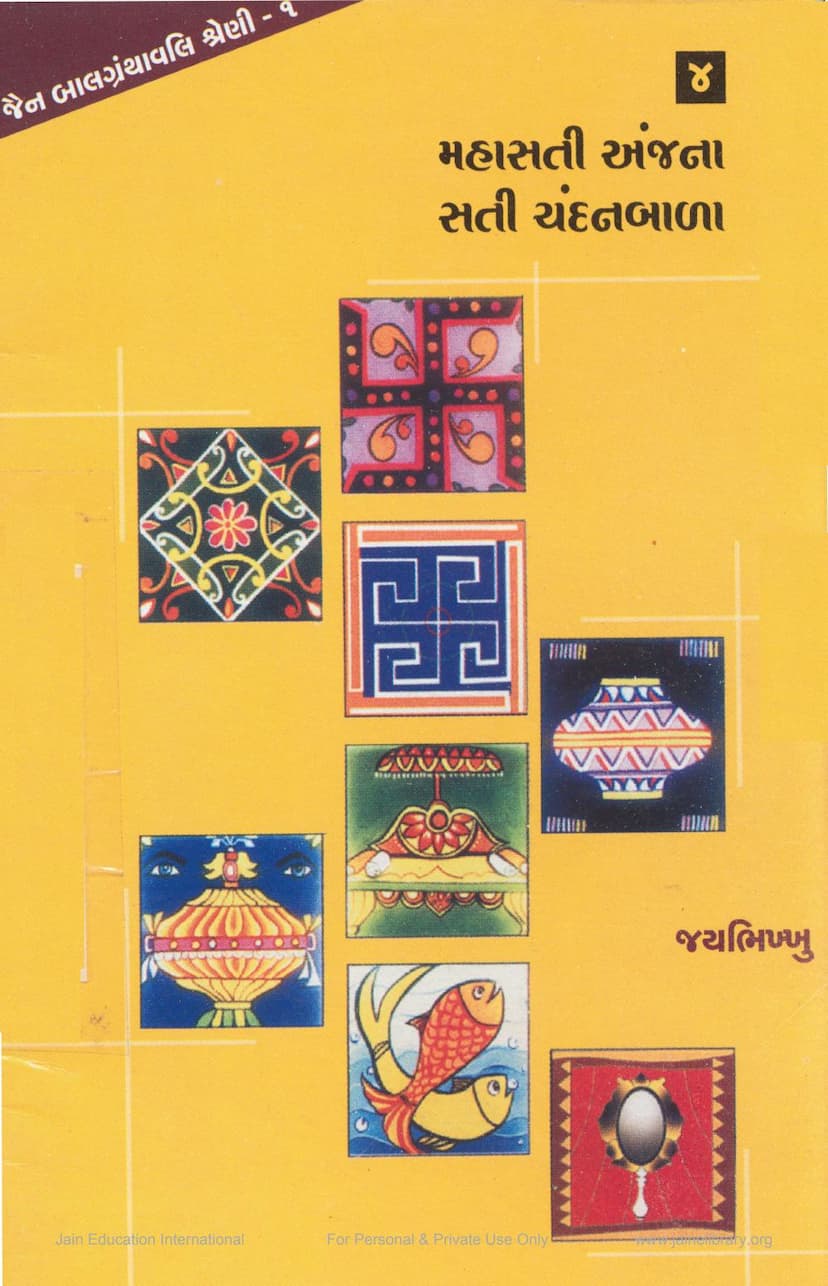Mahasati Anjana Sati Chandanbala
Added to library: September 2, 2025

Summary
Here is a comprehensive summary of the Jain text "Mahasati Anjana Sati Chandanbala" by Jaybhikkhu, based on the provided pages:
This book is part of the "Jain Balgranthavali Shreni - 1" series, published by the Jaybhikkhu Sahitya Trust. It is dedicated to inspiring young readers with the lives of revered Jain figures. The volume specifically focuses on two prominent Jain women: Mahasati Anjana and Sati Chandanbala.
Part 1: Mahasati Anjana
The narrative begins by introducing Anjana, the mother of Lord Hanuman, emphasizing her virtuous nature and status as a "Mahasati" (great chaste woman).
- Early Life and Marriage: Anjana was the beautiful and virtuous daughter of King Mahendra. After her birth, the king searched for a suitable groom. Two princes were considered: Pavanajita, a brave and wise prince, and Vidyaprabha, a learned astrologer whose life was predicted to be short, leading to renunciation and liberation. Anjana was betrothed to Pavanajita.
- Misunderstanding and Estrangement: Before the wedding, Pavanajita disguised himself and visited Anjana's city. He overheard Anjana and her friends discussing the princes. Anjana praised Vidyaprabha for his potential spiritual path, which Pavanajita misinterpreted as her affection for Vidyaprabha. This led to deep resentment. After their marriage, Pavanajita refused to speak to or interact with Anjana, causing her immense sorrow. He even treated gifts sent from her parents disrespectfully.
- Anjana's Steadfastness: Despite Pavanajita's coldness and the resulting social isolation, Anjana remained devoted and virtuous. She endured twelve years of separation and mistreatment.
- Pavanajita's Realization: While going to war, Pavanajita witnessed the sorrow of a female chakva (a type of bird) separated from its mate for a single night. This made him reflect on Anjana's prolonged suffering and realize the depth of her devotion. His anger subsided, and he decided to return to her.
- Reconciliation and Birth of Hanuman: Pavanajita, with the help of a friend, secretly returned to Anjana's palace. Their reunion brought immense joy. Anjana became pregnant that very night. When her pregnancy was discovered by her mother-in-law, Ketumati, Anjana presented a ring from Pavanajita as proof of his visit. However, Ketumati, disbelieving her, cast her out of the kingdom, dressed in black and exiled to the forest.
- Hardship and Divine Intervention: Abandoned in a dense forest with her loyal companion Vasantamala, Anjana gave birth to a son. This son, destined to be the mighty Hanuman, grew up in the forest, displaying extraordinary strength and courage. Anjana's virtuousness protected them from wild animals, including a lion.
- Recognition and Reunion: King Surasena of Hanupur, passing through the forest, heard Anjana's lament and discovered her and her son. Recognizing her as his niece, he took them to his kingdom, Hanupur. Her son was named Hanuman. Pavanajita, returning from war and learning of Anjana's banishment, was filled with regret. He searched for her, eventually finding her in Hanupur. A heartfelt reunion took place, with Pavanajita seeking Anjana's forgiveness.
- Renunciation: After some years of happy married life, Anjana, guided by her spiritual inclination, decided to embrace asceticism (renunciation) for the welfare of her soul. Pavanajita, persuaded by her, also renounced worldly life. They took diksha (initiation) and dedicated their lives to spiritual practice.
Part 2: Sati Chandanbala
The second part of the book introduces Chandanbala (initially named Vasumati), highlighting her purity and resilience.
- Early Life: Vasumati was the beloved daughter of King Dadhivahana and Queen Dharini of Champanagari. She was known for her beauty, intelligence, and artistic talents, receiving a comprehensive education in various arts and sciences, as well as Jain Dharma.
- Invasion and Capture: Champanagari was invaded by King Shatānika of Kausambi. Despite fierce resistance, the city fell. King Dadhivahana fled, and Queen Dharini and Princess Vasumati were captured by Shatānika's soldiers.
- Tragedy and Despair: While being taken away, Queen Dharini, confronted by a soldier's lecherous advances, chose to die rather than compromise her chastity. Vasumati, witnessing her mother's death and facing a similar threat, also succumbed to despair.
- Slavery and Renaming: The soldier brought Vasumati to Kausambi and sold her in the market. She was bought by a kind merchant named Dhanavaha, who, impressed by her demeanor, took her in as a daughter. Due to her sweet and soothing nature, she was renamed Chandana.
- Suffering and Purity: Chandana faced further hardship when Dhanavaha's wife, Mūla, driven by jealousy, believed Dhanavaha was attracted to Chandana. Mūla brutally shaved Chandana's head, put shackles on her feet, and imprisoned her in a secluded room.
- Encounter with Lord Mahavir: Chandana, enduring her suffering with unwavering faith and chanting the Navkar Mantra, sat with one foot inside and one foot outside the threshold, eating dry lentil cakes. Lord Mahavir, on his alms round, was seeking a specific type of alms: from a chaste princess who was enslaved, with shackles on her feet, a shaven head, hungry, weeping, and seated in that specific posture with the cakes. He found all conditions met except the tears. When Chandana, seeing him leave without accepting alms, began to weep, he finally accepted her alms.
- Liberation and Enlightenment: Upon Lord Mahavir accepting her alms, Chandana's shackles miraculously broke. The entire city rejoiced. King Shatānika's queen, Mrigavati, recognized Chandana as her niece and brought her back to the royal palace.
- Spiritual Path: Despite her return to royalty, Chandana's heart yearned for Lord Mahavir. When he attained Kevala Jnana (omniscience), Chandana took diksha from him, becoming his foremost and most respected nun.
- Vow and Meritorious Life: She undertook severe penances and ascetic practices, purifying her mind, speech, and body. She became a leader of 36,000 nuns and inspired many other women to follow the spiritual path. She lived a life of dedication and renunciation, ultimately attaining Nirvana.
The book emphasizes the virtues of chastity, devotion, resilience, and the ultimate triumph of righteousness through faith and spiritual practice, as exemplified by both Mahasati Anjana and Sati Chandanbala.